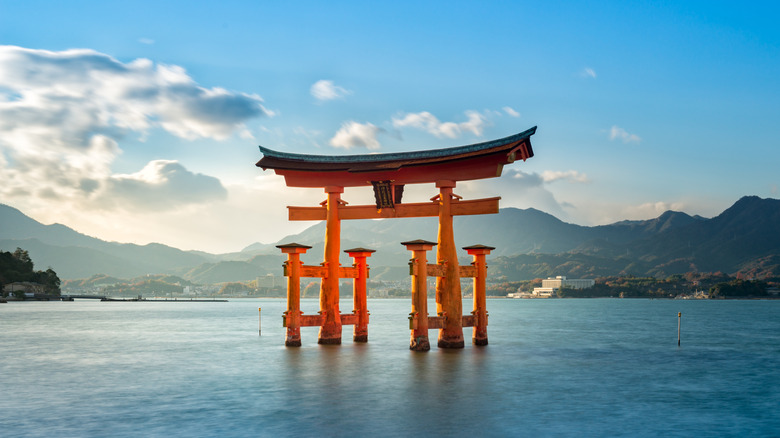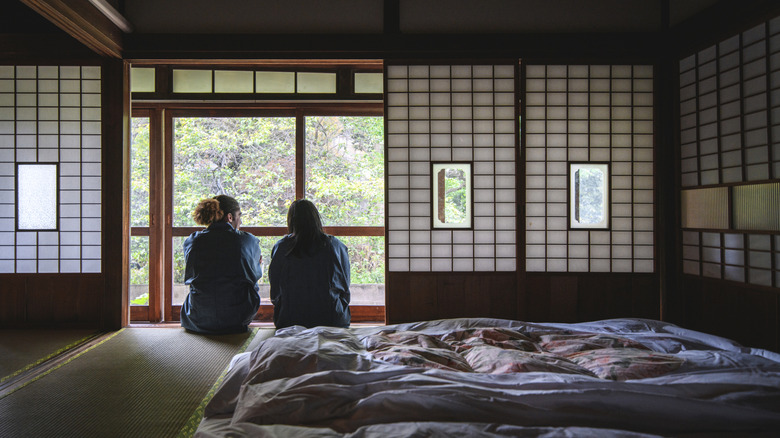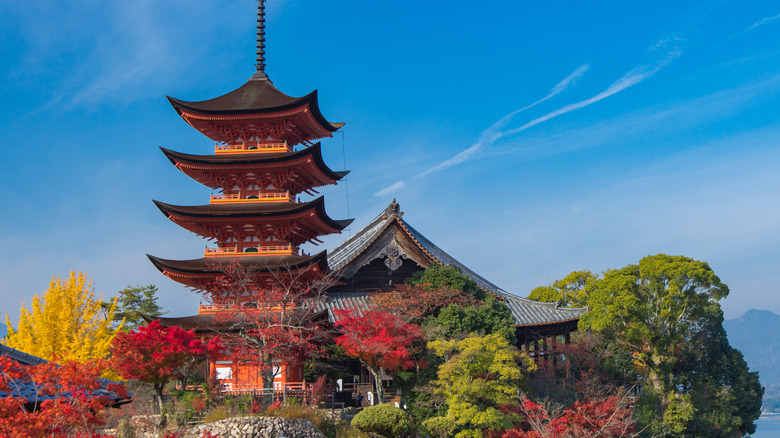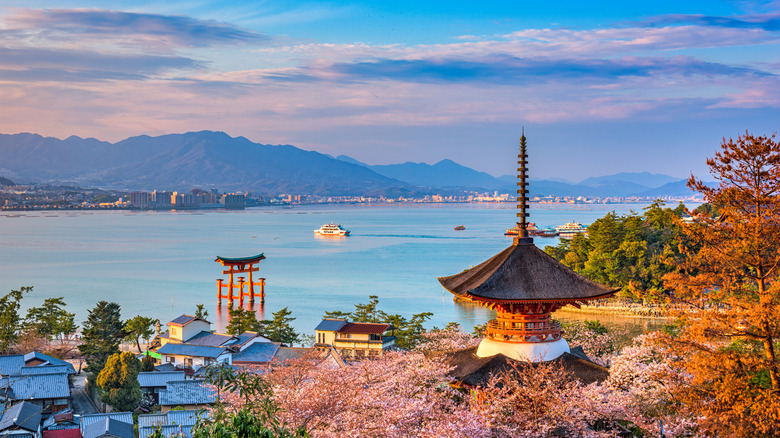Rising up from the waters of the Seto Inland Sea in Japan, two bright orange pillars and a curved crosspiece form an impressive entryway into a spiritual world. This is the famous torii gate of Itsukushima Shrine off the coast of Miyajima, an island not far from the city of Hiroshima that is widely considered one of the three most beautiful views in the entire country.
Though officially named Itsukushima, it’s more commonly known as Miyajima, which means “shrine island” in Japanese. Around the year 593, the lacquered vermilion entrance gate to Itsukushima Shrine was built over the water, as the locals considered the island to be so sacred, they feared causing offense if the land was disturbed. Now a World Heritage site, Miyajima’s famed shrine, which appears to float on a glassy surface at high tide, has been such a popular tourist destination that local officials introduced a small tax on foreign visitors, with numbers reaching nearly 3 million in 2023, according to Asahi Shimbun. The tax is minuscule (costing a mere 100 yen, or around 60 cents USD, as of this writing) but is meant to help keep the island pristine for all future visitors.
But tourists will find much more than an ancient shrine here — Miyajima is home to a population of about 500 deer who make their dens in the island’s forests. Deer in Japan are considered sacred messengers of the gods, and for this reason, Miyajima’s deer are protected from hunting and permitted to wander the island freely. While shy, the deer are rather tame and may approach you, but a sign at the island’s entrance asks that you don’t feed them. However, if you’re looking for deer in Japan you are allowed to feed, visit this laidback but culture-rich Japanese city.
Stay in a traditional Japanese-style guesthouse on Miyajima
As the island certainly can get busy, a great way to properly experience all Miyajima has to offer is to stay overnight — especially in a ryokan, which is a traditional Japanese-style inn. Ryokan all across Japan are famed for their classic architecture and exceptional local cuisine, as well as steamy mineral hot spring baths called onsen, perfect for relaxing after a busy day exploring. While some ryokan do have Western-style rooms with normal beds, one of the most iconic features of these establishments are the woven straw mats (called tatami) covering the floors, with guests sleeping on fluffy futon bedding instead.
There are several well-rated ryokan on Miyajima, such as Iwaso, located a mere six-minute walk from Itsukushima Shrine and surrounded by the maple trees of the nearby Momijidani Park. Built in 1854 during the Edo Period, Iwaso offers stunning tatami-style guest rooms with sliding doors opening to views of the landscape and has extensive outdoor hot spring facilities where you might encounter Miyajima’s deer in their natural habitat. Another great option is Kinsuikan, which boasts private hot spring baths right in your room overlooking the sea and serves excellent seasonal dishes. Remember, since chopsticks are the primary eating utensil in Japan, make sure you don’t commit this common dining faux pas when sitting down for dinner.
While staying at a ryokan, guests are also encouraged to trade their Western clothing for Japanese-style belted robes called yukata, a light cotton garment that’s easy to slip on and off when it comes time to use the onsen baths. It’s normal for most ryokan to be on the pricier side, but even a one-night stay is enough to be warmed by the charms of traditional Japanese hospitality.
Shrines, temples, and other attractions in Miyajima
Tips for getting to Miyajima and the best times to visit
To reach Miyajima, you’ll need to take a plane, a train, and a boat, but don’t worry — it’s not as complicated as it sounds. If you’re flying in to Tokyo, you’ll either land at Narita or Haneda Airport, and the easiest way from there will be to catch another flight to Hiroshima Airport. Upon arrival, make your way to Hiroshima Station and board the JR Sanyo train for roughly 20 minutes to Miyajimaguchi Station, where you’ll catch a 10-minute ferry to the island’s pier.
Japan is famous for its extensive high-speed railway system, so another great alternative once arriving in Tokyo is to take the Shinkansen instead and experience the thrill of Japan’s bullet trains. To get the most out of the numerous railway networks, it’s recommended to buy the Japan Rail Pass, an affordable option only available to foreign tourists. Departing from Tokyo Station, the Tokaido Shinkansen line will take you to Shin-Osaka Station (look out the window to spot Mount Fuji on the way), where you’ll change to the Sanyo Shinkansen to reach Hiroshima, with the journey lasting about four hours total. If you purchase the Japan Rail Pass, the train from Hiroshima Station to Miyajimaguchi Station will be free of charge, as well as the ferry to Miyajima.
While certainly beautiful all year, one of Miyajima’s best seasons is autumn, when the maple trees around Mount Misen and Daisho-in Temple transition to reds and oranges in mid-November. The start of April is another memorable time to visit, as the cherry blossoms will reach their most stunning bloom, particularly around the Five-Storied Pagoda. Whichever season you choose, a trip to this ethereal island is sure to be unforgettable.





